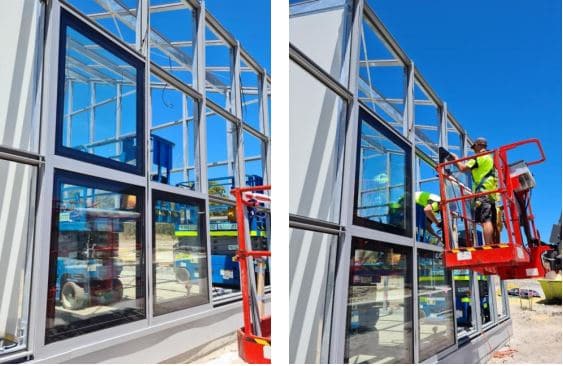ClearVue has begun installing the company’s transparent solar PV integrated glass units (IGU) on site at the $7.45m grains research precinct at Perth’s Murdoch University.
The greenhouse will utilise ClearVue’s transparent solar glass technology which is designed to preserve glass transparency while generating electricity. Data supplied by the company indicates the technology delivers a minimum of 30 watts per sqm while maintaining 70% transparency.
The IGUs feature solar PV cells around the edges of each unit. The units incorporate a nanoparticle interlayer and spectral-selective coating on the rear external surface which allow much of the light to pass through but redirects infrared and UV light to the edge of the IGU where it is harvested by solar cells
ClearVue CEO Ken Jagger said the company expects the greenhouse, when operational, will generate greater market awareness of its building-integrated PV (BIPV) technology.
“We are starting to see strong interest globally for the ClearVue product from greenhouse suppliers, growers and other protected cropping end-users,” he said.
“We expect the fully constructed greenhouse to lead to an even greater market awareness of our technology and product.”
Main construction of the supporting greenhouse structure was completed in December and the installation of glazing is expected to be finished within the coming weeks ahead of commissioning with plant trials due to start in March or April.
The greenhouse is being built adjacent to two recently completed polycarbonate research greenhouses that form part of a larger research precinct.
The project is the first commercial-scale demonstration of ClearVue’s PV IGU technology in a protected-cropping agriculture setting and the company is confident it will perform well.
ClearVue’s data sheet indicates traditional greenhouses experience a temperature range of +/-6° from optimum temperature while its technology delivers a temperature range of +/-2° from the optimum temperature, providing an increased growth rate of up to 20-30%.
“We look forward to updating the market once the greenhouse is commissioned in the next few months, and as the larger research aspects of the project progresses,” Jagger said.
When work began on the greenhouse in December, Jagger said the project marked a “major milestone for the company”.
Jagger said the trial results would not only help facilitate the commercial application of the technology across protected-cropping agriculture markets, but also across high-rise commercial buildings.
While BIPV is yet to enjoy the same widespread deployment as building-applied PV (BAPV),it has been identified by the Australian PV Institute (APVI) as one of five key avenues for increased market penetration of PV.
The APVI said the multi-functionality of BIPV meant it had huge potential.
This content is protected by copyright and may not be reused. If you want to cooperate with us and would like to reuse some of our content, please contact: editors@pv-magazine.com.









4 comments
By submitting this form you agree to pv magazine using your data for the purposes of publishing your comment.
Your personal data will only be disclosed or otherwise transmitted to third parties for the purposes of spam filtering or if this is necessary for technical maintenance of the website. Any other transfer to third parties will not take place unless this is justified on the basis of applicable data protection regulations or if pv magazine is legally obliged to do so.
You may revoke this consent at any time with effect for the future, in which case your personal data will be deleted immediately. Otherwise, your data will be deleted if pv magazine has processed your request or the purpose of data storage is fulfilled.
Further information on data privacy can be found in our Data Protection Policy.